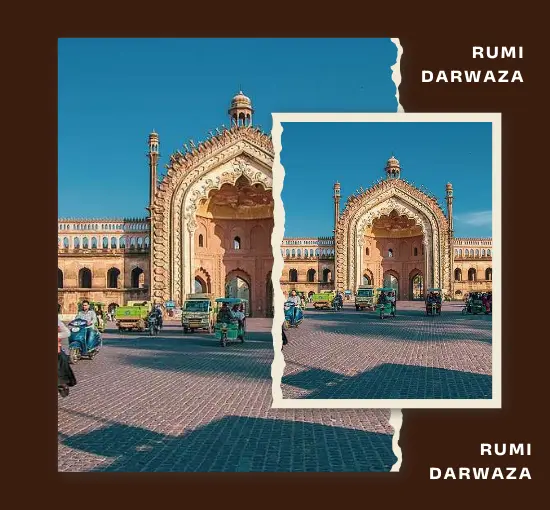

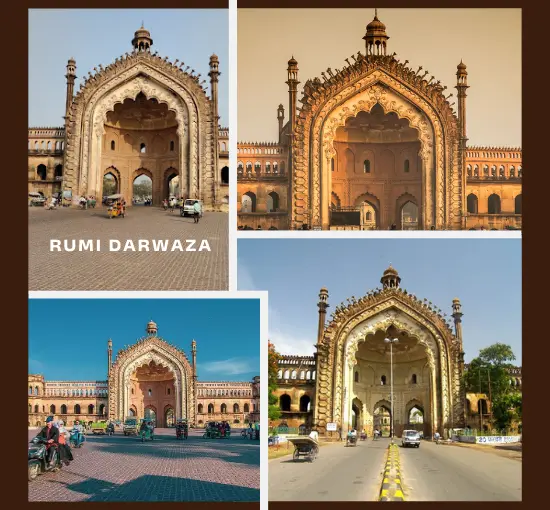
➡️ About Rumi Darwaza, Lucknow
The Rumi Darwaza, also known as the Turkish Gate, is one of Lucknow’s most iconic landmarks. Built in 1784 by Nawab Asaf-ud-Daula, this grand gateway is a fine example of Awadhi architecture. Standing 60 feet tall, it was inspired by the Sublime Porte in Istanbul, Turkey.
Located in the heart of Lucknow, Uttar Pradesh, Rumi Darwaza is situated close to historic sites like Asafi Imambara and Teele Wali Masjid. In its early days, it served as the entrance to Old Lucknow. As the city expanded, it became the gateway to a magnificent palace, which was later demolished by the British Raj after the Indian Rebellion of 1857.
Today, Rumi Darwaza stands as a proud symbol of Lucknow’s rich heritage and architectural brilliance. Its intricate design and historical significance continue to attract visitors from all over the world, making it a must-visit landmark in the city.
Beyond being a historical monument, Rumi Darwaza represents the city’s rich cultural heritage and resilience. Whether viewed during the day or illuminated at night, this architectural marvel continues to captivate visitors, making it an unforgettable part of Lucknow’s skyline
Coordinates: 26°51′38″N 80°54′57″E
Visiting Hours: Open 24 hours
➡️ History of Rumi Darwaza
During the rule of Nawab Asaf-Ud-Daula, a famine struck the region, leaving many people without food or jobs. To help his people, he introduced a food-for-work program, where those in need could earn food by working on construction projects. One of the most remarkable structures built during this time was the Rumi Darwaza. Inspired by the Sublime Porte in Istanbul, it was designed to be a grand gateway, symbolizing the elegance of Awadhi architecture. The construction not only provided relief to thousands but also left behind an architectural marvel that still stands today.
Architectural Beauty
During the rule of Nawab Asaf-Ud-Daula, a famine struck the region. To help people, he started a food-for-work program, and as part of this, the Rumi Darwaza was built. Its design was inspired by the grand gateway of Istanbul, known as the Sublime Porte.
➡️ PHOTO GALLERY

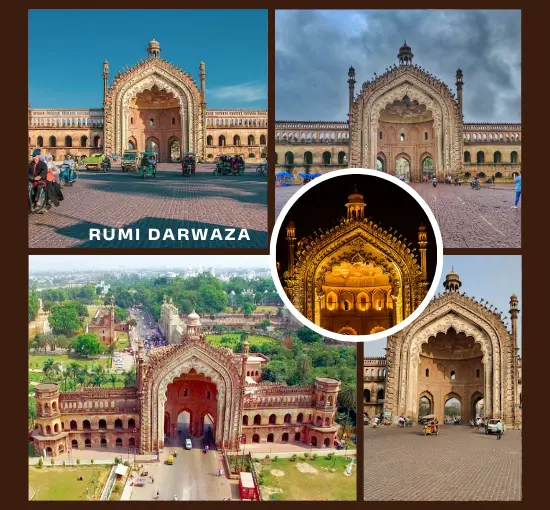
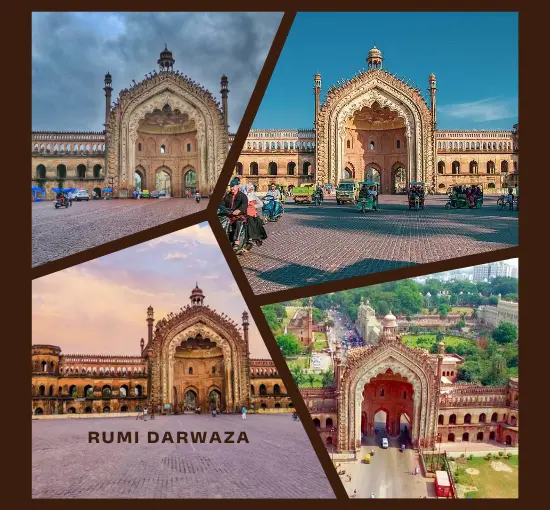
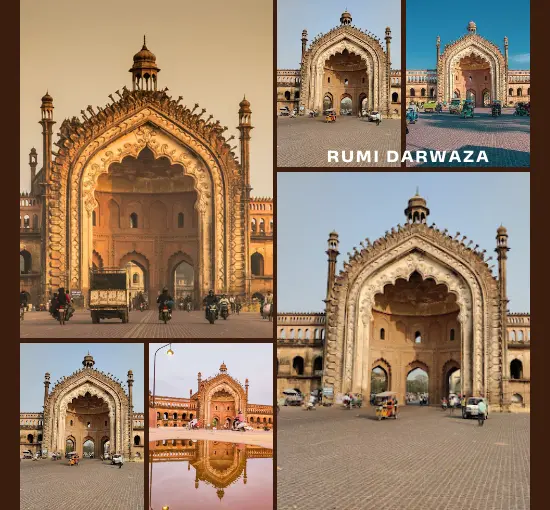

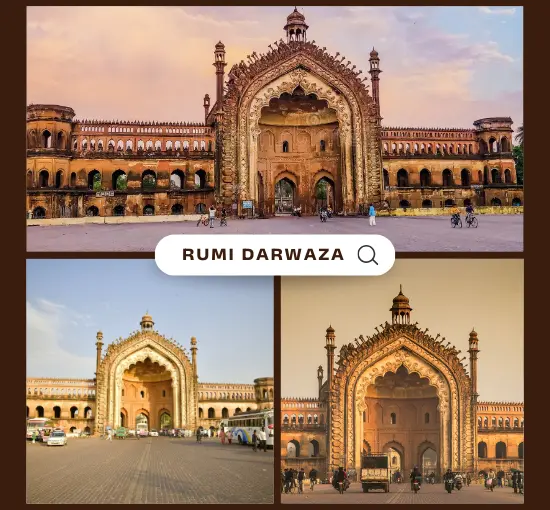
➡️ Why You Should Visit Rumi Darwaza?
Rumi Darwaza is a must-visit for history lovers, architecture enthusiasts, and travelers exploring Lucknow’s rich heritage. This 60-foot-tall gateway, built in 1784 by Nawab Asaf-ud-Daula, showcases stunning Awadhi architecture with intricate carvings and grand domes. Inspired by the Sublime Porte of Istanbul, it is a perfect spot for photography and sightseeing. Located near iconic landmarks like Bara Imambara and Teele Wali Masjid, it offers a glimpse into the city’s glorious past. Whether you're drawn by its history, design, or cultural significance, Rumi Darwaza is a landmark that truly captures the essence of Lucknow
➡️ Location and How to Reach
Rumi Darwaza is in the heart of Lucknow and can be easily reached by road. It is a popular tourist spot and a great place to explore during the day or night when it is beautifully lit up.
📍 Address: 17/11 Hussainabad Road, Lajpat Nagar Colony, Lajpat Nagar, Machchhi Bhavan, Lucknow, Uttar Pradesh 226003
Coordinates: 26°51′38″N 80°54′57″E
Visiting Hours: Open 24 hours
📍 Find Us on Google Maps➡️ Some Tourists Review
“Exquisite architecture and very well preserved main structure. One of the most important places in the history of the British Empire and India's fight for independence. But sadly, the good part ends here. To be honest, the place is just …”– Nishant Kapoor
"“Visiting Rumi Darwaza in Lucknow is like stepping into a royal past. This towering 60-foot gateway, often called the Turkish Gate, stands majestically in the heart of the city. The intricate Mughal-style carvings and grand archways make it” - Neeraj Sharma
“Wonderful monument. Must visit for people who visit lucknow. We can dive into the rich history of nawabs, experience the amazing architecture & relish the amazing local cuisine around the place.... – Maturu Tulasi
“Rumi Durwaza - the Turkish gate - was built by Nawab Asaf Ud Daula. Adjacent to Imambara the architecture is Awadhi (not Mughal) and was the entrance to old Lucknow“– Avinash Karve
Rumi Darwaza is an iconic monument in Lucknow, Uttar Pradesh, showcasing stunning Mughal architecture. This 60-feet-tall gateway is a must-visit attraction, with its intricate carvings and designs leaving visitors in awesome.. ❣️”– Shivani Verma
“Rumi Darwaza is a stunning piece of Mughal architecture that truly captures the essence of Lucknow. I visited on a weekday, and it was peaceful, allowing me to admire its grandeur without the crowds. The intricate design and historical charm make it a must-visit. A beautiful glimpse into history! ”– Chirag Chaudhary
➡️ PHOTO GALLERY



➡️ FREQUENTLY ASKED QUESTIONS
-
What is Rumi Darwaza?
Rumi Darwaza is a historic gateway in Lucknow, Uttar Pradesh, India, built in 1784 by Nawab Asaf-ud-Daula. It is an iconic example of Awadhi architecture and is sometimes called the Turkish Gate.
-
Why was Rumi Darwaza built?
Rumi Darwaza was constructed as part of a famine relief program initiated by Nawab Asaf-ud-Daula to provide employment to the people of Awadh. It also served as a grand entrance to Old Lucknow.
-
How tall is Rumi Darwaza?
Rumi Darwaza stands 60 feet (18 meters) tall, making it an imposing and impressive gateway in the city of Lucknow.
-
What is the architectural significance of Rumi Darwaza?
Rumi Darwaza is a stunning example of Awadhi architecture, inspired by the Sublime Porte in Istanbul, Turkey. It features intricate floral designs, domes, and detailed carvings, reflecting the grandeur of Mughal and Persian influences.
-
Where is Rumi Darwaza located?
Rumi Darwaza is situated in the heart of Lucknow, near famous landmarks such as Asafi Imambara and Teele Wali Masjid.
-
What was the role of Rumi Darwaza in history?
Initially, it served as the entrance to Old Lucknow. Later, it became the gateway to a palace, which was demolished by the British Raj after the Indian Rebellion of 1857.
-
Is Rumi Darwaza open to visitors?
Yes, Rumi Darwaza is open to visitors throughout the year. It is a popular tourist attraction and a must-visit site for history and architecture enthusiasts.
-
Why is Rumi Darwaza an important symbol of Lucknow?
Rumi Darwaza represents Lucknow’s rich history, cultural heritage, and architectural brilliance. It is one of the most recognizable landmarks of the city and continues to attract visitors from around the world.
➡️ Why is Rumi Darwaza So Famous?
Rumi Darwaza is famous for its architectural grandeur, historical significance, and cultural importance. Here are the key reasons why this iconic structure is well-known:
- Architectural Brilliance
Rumi Darwaza is a remarkable example of Awadhi architecture, featuring intricate floral patterns, detailed carvings, and a majestic design. It stands 60 feet tall and was modeled after the Sublime Porte in Istanbul, Turkey, showcasing a blend of Mughal and Persian influences.
- Built as a Symbol of Resilience
This gateway was constructed in 1784 by Nawab Asaf-ud-Daula as part of a famine relief project. During a devastating famine in Awadh, the Nawab initiated large-scale construction projects like the Rumi Darwaza to provide employment to the people.
- Historical Importance
Rumi Darwaza once served as the grand entrance to Old Lucknow, marking the city's royal and cultural prominence. Later, it became the gateway to a palace that was demolished by the British Raj after the Indian Rebellion of 1857, making it a silent witness to India's colonial history.
- A Symbol of Lucknow’s Heritage
Over time, Rumi Darwaza has become a symbol of Lucknow’s rich cultural and architectural heritage. It is frequently featured in tourism promotions, films, and literature as an emblem of the city.
- Major Tourist Attraction
Today, Rumi Darwaza is one of the most visited landmarks in Lucknow. Its stunning design, historical legacy, and cultural significance continue to attract tourists, historians, and architecture enthusiasts from around the world.